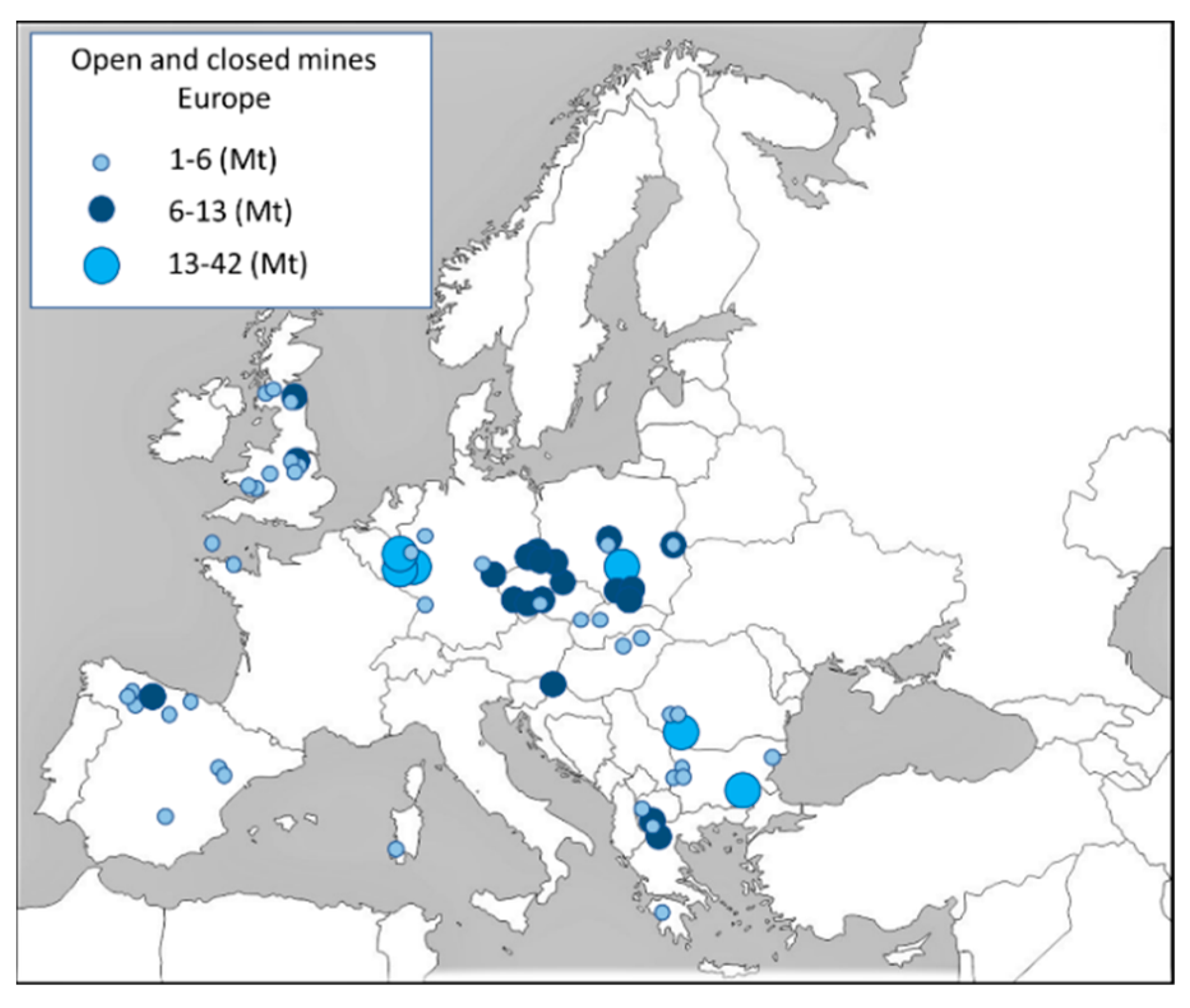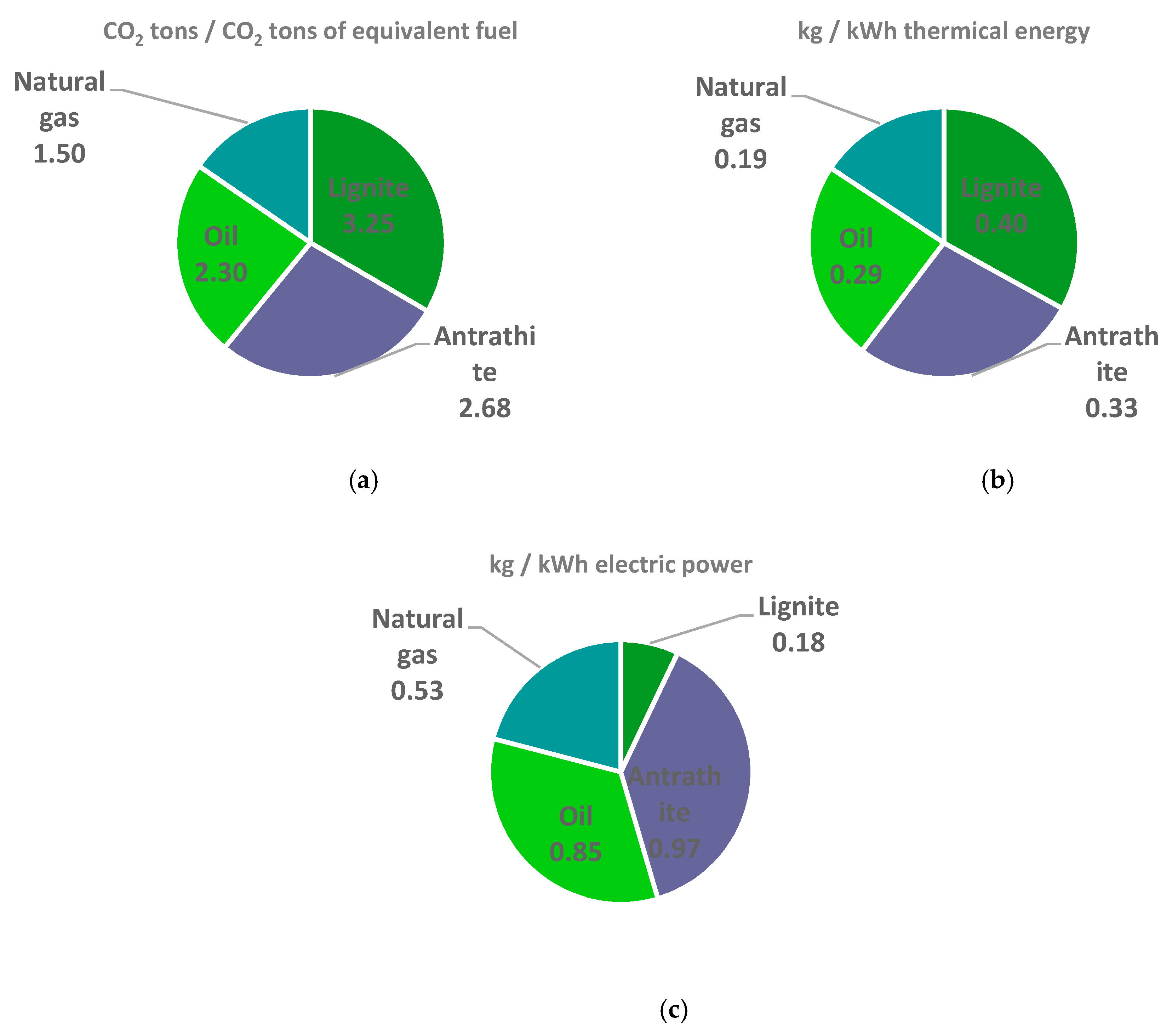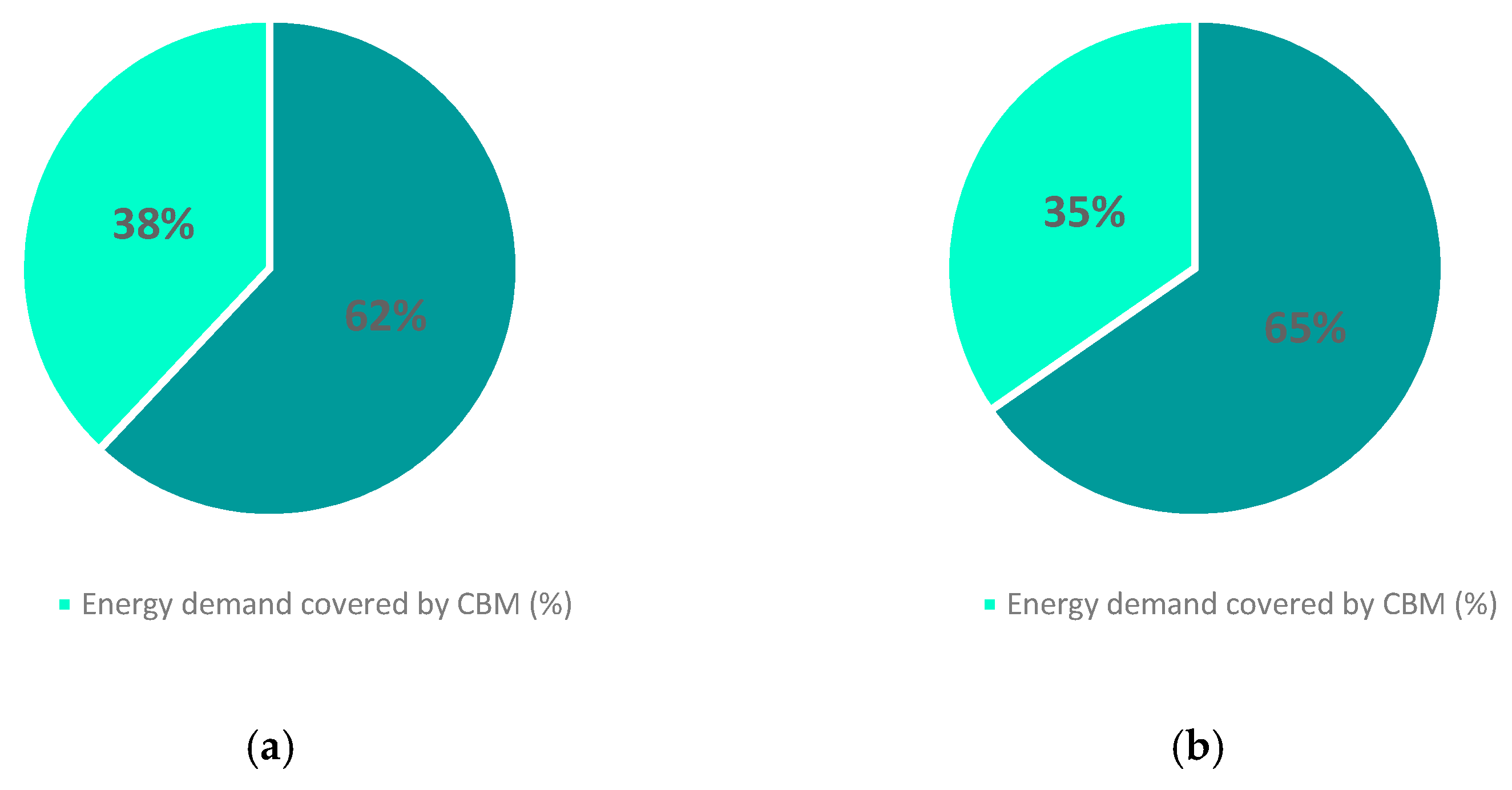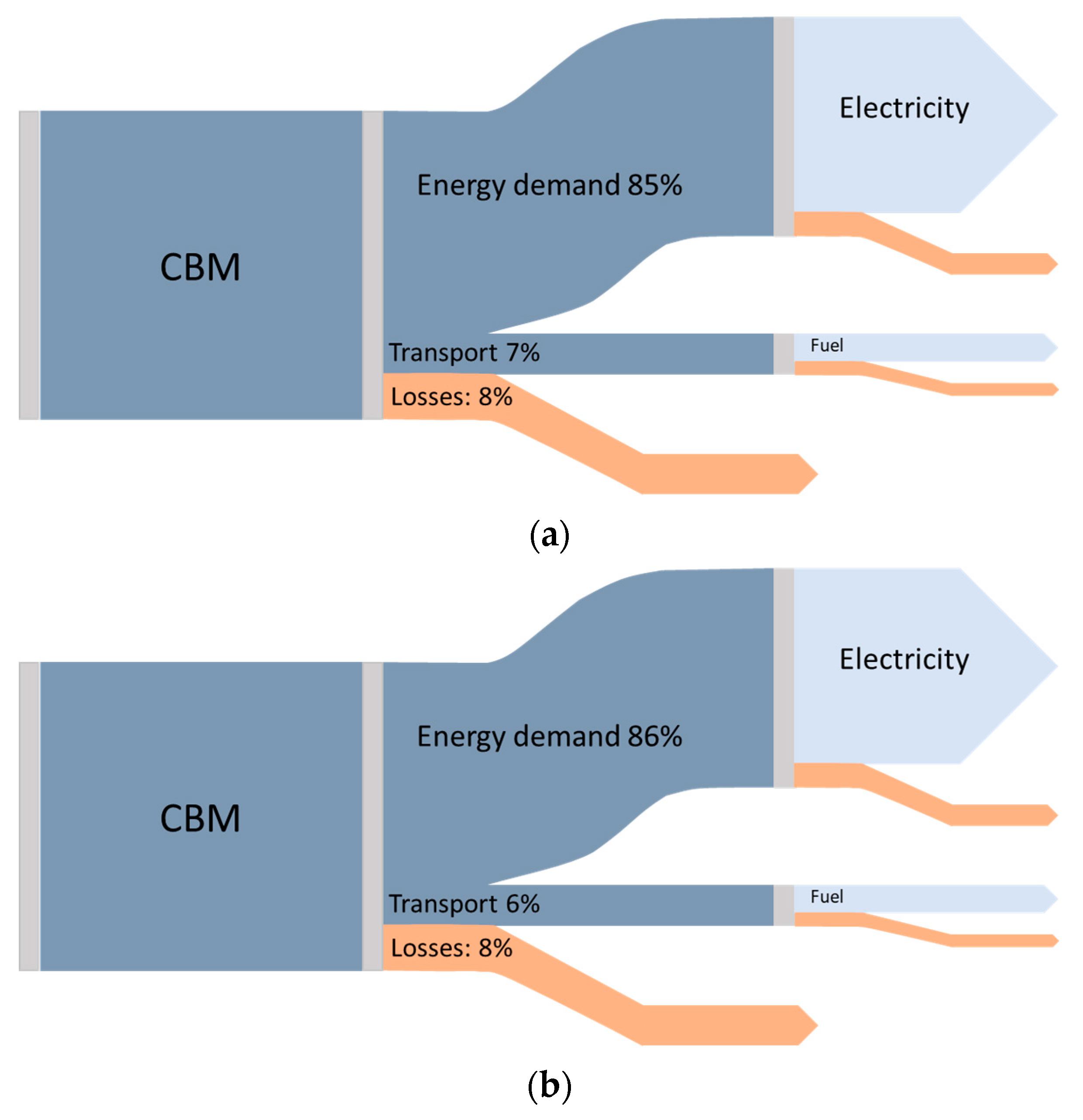Potential of CBM as an Energy Vector in Active Mines and Abandoned Mines in Russia and Europe
Abstract
1. Introduction
2. Methodology
2.1. Scenario’s Definition
2.2. Environmental Assessment of Degasification Technology
- Scenario 1: The direct CMM emissions;
- Scenario 2: The combustion products after the burning CBM and the harmful gases of the equipment used during the early degasification;
- Scenario 3: Again, the gases of the equipment used during the degasification and combustion products are emitted. However, if methane is used as fuel gas, there will be a reduction in combustion emissions from other sources.
- MCO,y is the carbon monoxide efficiency during the combustion of the extracted gas, tons;
- BM is methane consumption in the combustion. In other words, the extracted methane, m3;
- qM is the methane composition of CBM steam (estimated at 90%);
- CCO is the calorific potential associated with incomplete combustion calculated by Equation (2), exposed below.
- KNO2 is a parameter that characterizes the number of nitrogen oxides generated per 1 GJ of heat (0.08 kg/GJ) [41];
- β is a coefficient that considers the degree of reduction of nitrogen oxide emissions as a result of the application of technical solutions (estimated at 0).
2.3. Economical Assessment of Early Degasification Technology
- E is the economic effect of early degasification;
- E1 is the economic effect of increasing the rate of development work;
- E2 is the economic effect of increasing the load work in the mine;
- E3 is the economic effect of the extracted methane utilization (methane sales);
- E4 is the economic effect of reducing methane emissions to the atmosphere.
- V1/V2 is the average rate of development working in the mine and in the area of early degassing preparation (%);
- Ks coefficient of the discrepancy between the decrease in the number of existing development faces and sections and the rate of growth in the speed of workings (%);
- CD is the production cost of mining 1 ton of coal before the introduction of new technology (USD/t);
- D1 is the annual mining production in the previous period (t);
- γfc. is the proportion of the conditionally fixed costs of development work over the general cost of the mine (%);
- Vst is the volume of mining work in the studied area (m3);
- Vm is the volume of the whole mine (m3).
- q is the coefficient of growth of the load work (%), which includes the cost of fueling the early degasification reaction process;
- γ* fc is the proportion between the fixed cost of work intensification and the cost of 1 ton of coal (%);
- D1s the daily load before implementation (t/day);
- N the number of days for mining this area.
- QM is the amount of extracted methane (m3);
- Scoal is the calorific value of 1 kg of coal (MJ);
- Smethane is the calorific value of 1 m3 of methane expressed in (MJ).
- Δi is the reduction of certain types of emissions by replacing coal with methane (m3);
- θi is the amount of payment per unit of corresponding emissions (USD/m3).
3. Results and Discussion
European and Russian Potential for CBM Utilization
4. Conclusions
- (a)
- There is a need to improve CBM extraction and cleaning technologies to increase combustion efficiency and enable its use in sectors such as transport;
- (b)
- Actions for the application of such technologies should be encouraged. Legislation can help countries such as Russia to reduce pollution from their mines by 35%;
- (c)
- A scenario in which emissions are penalized would mean that scenario 1 would have the same costs as scenario 2, thus reducing emissions by 11.6 tons of CO2 per year per mine.
Author Contributions
Funding
Data Availability Statement
Conflicts of Interest
References
- Zheng, X.; Streimikiene, D.; Balezentis, T.; Mardani, A.; Cavallaro, F.; Liao, H. A review of greenhouse gas emission profiles, dynamics, and climate change mitigation efforts across the key climate change players. J. Clean. Prod. 2019, 234, 1113–1133. [Google Scholar] [CrossRef]
- Zafrilla, J.E. The mining industry under the thumb of politicians: The environmental consequences of the Spanish Coal Decree. J. Clean. Prod. 2014, 84, 715–722. [Google Scholar] [CrossRef]
- Ritchie, H.; Roser, M.; Rosado, P. CO2 and Greenhouse Gas Emissions. Our World in Data. 2017. Available online: https://ourworldindata.org/co2-and-other-greenhouse-gas-emissions (accessed on 15 August 2020).
- Wang, K.; Zhang, J.; Cai, B.; Yu, S. Emission factors of fugitive methane from underground coal mines in China: Estimation and uncertainty. Appl. Energy 2019, 250, 273–282. [Google Scholar] [CrossRef]
- IEA. Key World Energy Statistics 2021—Statistics Report; IEA: Paris, France, 2021. [Google Scholar]
- IEA. IEA, Global Coal Production, 2018–2021, IEA Statistics, Paris; IEA: Paris, France, 2021. [Google Scholar]
- Łupieżowiec, M.; Rybak, J.; Różański, Z.; Dobrzycki, P.; Jędrzejczyk, W. Design and Construction of Foundations for Industrial Facilities in the Areas of Former Post-Mining Waste Dumps. Energies 2022, 15, 5766. [Google Scholar] [CrossRef]
- Drygin, M.; Kurychkin, N.; Bakanov, A. Strategy of Russian Coal Mining Enterprises’ Excavator Park Technical State Correction. E3S Web Conf. 2017, 15, 3011. [Google Scholar] [CrossRef]
- Alves Dias, P.; Kanellopoulos, K.; Medarac, H.; Kapetaki, Z.; Miranda Barbosa, E.; Shortall, R.; Czako, V.; Telsnig, T.; Vazquez Hernandez, C.; Lacal Arantegui, R.; et al. EU Coal Regions: Opportunities and Challenges Ahead; JRC Science for Policy Report; Publications Office of the European Union: Luxembourg, 2018. [Google Scholar]
- Bondaruk, J.; Janson, E.; Wysocka, M.; Chałupnik, S. Identification of hazards for water environment in the Upper Silesian Coal Basin caused by the discharge of salt mine water containing particularly harmful substances and radionuclides. J. Sustain. Min. 2015, 14, 179–187. [Google Scholar] [CrossRef]
- Adesina, J.; Piketh, S.; Qhekwana, M.; Burger, R.; Language, B.; Mkhatshwa, G. Contrasting indoor and ambient particulate matter concentrations and thermal comfort in coal and non-coal burning households at South Africa Highveld. Sci. Total. Environ. 2019, 699, 134403. [Google Scholar] [CrossRef]
- Xie, X.; Ai, H.; Deng, Z. Impacts of the scattered coal consumption on PM2.5 pollution in China. J. Clean. Prod. 2019, 245, 118922. [Google Scholar] [CrossRef]
- The Global Methane Initiative (GMI). The US Government’s Global Methane Initiative Accomplishments; GMI: Washington, DC, USA, 2011. [Google Scholar]
- Wang, H.; Cheng, Y.; Wang, W.; Xu, R. Research on comprehensive CBM extraction technology and its applications in China’s coal mines. J. Nat. Gas Sci. Eng. 2014, 20, 200–207. [Google Scholar] [CrossRef]
- Shi, J.; Zeng, L.; Zhao, X.; Zhang, Y.; Wang, J. Characteristics of natural fractures in the upper Paleozoic coal bearing strata in the southern Qinshui Basin, China: Implications for coalbed methane (CBM) development. Mar. Pet. Geol. 2019, 113, 104152. [Google Scholar] [CrossRef]
- Jiang, J.; Cheng, Y.; Zhang, P.; Jin, K.; Cui, J.; Du, H. CBM drainage engineering challenges and the technology of mining protective coal seam in the Dalong Mine, Tiefa Basin, China. J. Nat. Gas Sci. Eng. 2015, 24, 412–424. [Google Scholar] [CrossRef]
- Zhang, L.; Aziz, N.; Ren, T.; Nemcik, J.; Tu, S. Nitrogen Injection To Flush Coal Seam Gas Out Of Coal: An Experimental Study. Arch. Min. Sci. 2015, 60, 1013–1028. [Google Scholar] [CrossRef]
- Liu, P.; Fan, L.; Li, Q.; Zhong, F. Power ultrasound assisted coalbed methane enhancement recovery: Field application and performance evaluation in underground coal mine. Fuel 2022, 324, 124575. [Google Scholar] [CrossRef]
- Boal, W.M. Work intensity and worker safety in early twentieth-century coal mining. Explor. Econ. Hist. 2018, 70, 132–149. [Google Scholar] [CrossRef]
- Taveau, J. Application of Dust Explosion Protection Systems. Procedia Eng. 2014, 84, 297–305. [Google Scholar] [CrossRef]
- Xuhui, Z. Evaluation and Testing of an Intelligent Methane Detecting System. Procedia Eng. 2011, 15, 3843–3847. [Google Scholar] [CrossRef]
- Echeverri, D.R.; Ríos Cano, S.H.; Jiménez Builes, J.A. Detección y control de atmósferas explosivas en minas subterráneas de carbón usando programación estructurada. Rev. Educ. Ing. 2012, 7, 10–21. Available online: http://search.ebscohost.com/login.aspx?direct=true&db=fua&AN=93913523&lang=es&site=ehost-live (accessed on 15 September 2022).
- He, Z.; Wu, Q.; Wen, L.; Fu, G. A process mining approach to improve emergency rescue processes of fatal gas explosion accidents in Chinese coal mines. Saf. Sci. 2019, 111, 154–166. [Google Scholar] [CrossRef]
- Lööw, J.; Nygren, M. Initiatives for increased safety in the Swedish mining industry: Studying 30 years of improved accident rates. Saf. Sci. 2019, 117, 437–446. [Google Scholar] [CrossRef]
- Zaburdyaev, V.S. Degassing of the developed reservoir is an effective way to increase productivity and safety of work in methane-rich mines. Mt. Inf. Anal. Bull. 2000, 1, 13–16. Available online: https://cyberleninka.ru/article/n/degazatsiya-razrabatyvaemogo-plasta-effektivnyy-sposob-povysheniya-proizvoditelnosti-i-bezopasnosti-rabot-v-metanoobilnyh-shahtah (accessed on 18 January 2023).
- Medvedev, D. Order of the Government of the Russian Federation of May 5, 2014 No. 410 about Procedure for Coordination and Approval of Investing Programs of the Organizations Performing Regulated Types of Activity in the Sphere of Heat Supply, and Also Requirements to Structure and Contents of Such Programs. 2014. Available online: https://cis-legislation.com/document.fwx?rgn=67147 (accessed on 15 July 2022).
- Amez, I.; Castells, B.; Garcia-Torrent, J.; Medic, L. Influence of the addition of hydrogen on the flammability intervals of the methane, air and CO2 mixtures. In Proceedings of the Air and Waste Management Association’s Annual Conference and Exhibition, AWMA, Quebec City, QC, Canada, 25–28 June 2019; Volume 9, p. 8. [Google Scholar]
- Xia, H.; Gui, F. Study on factors related to work stability of safety management in coal mining enterprises. Procedia Eng. 2011, 26, 2038–2043. [Google Scholar] [CrossRef]
- Karacan, C.Ö.; Ruiz, F.A.; Cotè, M.; Phipps, S. Coal mine methane: A review of capture and utilization practices with benefits to mining safety and to greenhouse gas reduction. Int. J. Coal Geol. 2011, 86, 121–156. [Google Scholar] [CrossRef]
- Batugin, A.; Kolikov, K.; Ivannikov, A.; Ignatov, Y.; Krasnoshtanov, D. Transformation of the Geodynamic Hazard Manifestation Forms in Mining Areas. In Proceedings of the 19th SGEM International Multidisciplinary Scientific GeoConference EXPO Proceedings, Vienna, Austria, 9–12 December 2019; Volume 2019, pp. 717–724. [Google Scholar] [CrossRef]
- Caglayan, H.; Caliskan, H. Thermodynamic based economic and environmental analyses of an industrial cogeneration system. Appl. Therm. Eng. 2019, 158, 113792. [Google Scholar] [CrossRef]
- Zheng, C.; Kizil, M.S.; Chen, Z.; Aminossadati, S.M. Role of multi-seam interaction on gas drainage engineering design for mining safety and environmental benefits: Linking coal damage to permeability variation. Process. Saf. Environ. Prot. 2018, 114, 310–322. [Google Scholar] [CrossRef]
- Krause, E.; Karbownik, M. Tests of methane desorption and emission from samples of hard coal in the context of mine closures through flooding. J. Sustain. Min. 2019, 18, 127–133. [Google Scholar] [CrossRef]
- Karacan, C.; Ulery, J.; Goodman, G. A numerical evaluation on the effects of impermeable faults on degasification efficiency and methane emissions during underground coal mining. Int. J. Coal Geol. 2008, 75, 195–203. [Google Scholar] [CrossRef]
- Ampah, J.D.; Jin, C.; Agyekum, E.B.; Afrane, S.; Geng, Z.; Adun, H.; Yusuf, A.A.; Liu, H.; Bamisile, O. Performance analysis and socio-enviro-economic feasibility study of a new hybrid energy system-based decarbonization approach for coal mine sites. Sci. Total. Environ. 2023, 854, 158820. [Google Scholar] [CrossRef]
- EU. Directive (EU) 2018/2001 of the European Parliament and of the Council of 11 December 2018 on the promotion of the use of energy from renewable sources (recast). Off. J. Eur. Union 2018, 2018, 82–209. [Google Scholar]
- Ghoniem, A.F. Needs, resources and climate change: Clean and efficient conversion technologies. Prog. Energy Combust. Sci. 2011, 37, 15–51. [Google Scholar] [CrossRef]
- Desantes, J.; Molina, S.; Novella, R.; Lopez-Juarez, M. Comparative global warming impact and NOX emissions of conventional and hydrogen automotive propulsion systems. Energy Convers. Manag. 2020, 221, 113137. [Google Scholar] [CrossRef]
- Kirchgessner, D.; Masemore, S.; Piccot, S. Engineering and economic evaluation of gas recovery and utilization technologies at selected US mines. Environ. Sci. Policy 2002, 5, 397–409. [Google Scholar] [CrossRef]
- Talibi, M.; Hellier, P.; Ladommatos, N. Combustion and exhaust emission characteristics, and in-cylinder gas composition, of hydrogen enriched biogas mixtures in a diesel engine. Energy 2017, 124, 397–412. [Google Scholar] [CrossRef]
- Cellek, M.S.; Pınarbaşı, A. Investigations on performance and emission characteristics of an industrial low swirl burner while burning natural gas, methane, hydrogen-enriched natural gas and hydrogen as fuels. Int. J. Hydrogen Energy 2018, 43, 1194–1207. [Google Scholar] [CrossRef]
- OCCC (Catalan Office for Climate Change). Practical Guide for Calculating Greenhose Gas (GHG) Emissions. 2019. Available online: https://canviclimatic.gencat.cat/web/.content/04_ACTUA/Com_calcular_emissions_GEH/guia_de_calcul_demissions_de_co2/190301_Practical-guide-calculating-GHG-emissions_OCCC.pdf (accessed on 5 February 2020).
- Wei, L.; Shengfei, Q.; Guoyi, H.; Yanjie, G. Accumulation of water-soluble gas by degasification: One of important mechanisms of large gas accumulations in the Xujiahe Formation, Sichuan Basin. Pet. Explor. Dev. 2011, 38, 662–670. [Google Scholar] [CrossRef]
- Karacan, C.; Olea, R.A. Stochastic reservoir simulation for the modeling of uncertainty in coal seam degasification. Fuel 2015, 148, 87–97. [Google Scholar] [CrossRef]
- Zhou, F.; Xia, T.; Wang, X.; Zhang, Y.; Sun, Y.; Liu, J. Recent developments in coal mine methane extraction and utilization in China: A review. J. Nat. Gas Sci. Eng. 2016, 31, 437–458. [Google Scholar] [CrossRef]
- Cheng, Y.-P.; Wang, L.; Zhang, X.-L. Environmental impact of coal mine methane emissions and responding strategies in China. Int. J. Greenh. Gas Control. 2011, 5, 157–166. [Google Scholar] [CrossRef]
- Tao, S.; Chen, S.; Pan, Z. Current status, challenges, and policy suggestions for coalbed methane industry development in China: A review. Energy Sci. Eng. 2019, 7, 1059–1074. [Google Scholar] [CrossRef]
- Tailakov, O.; Zastrelov, D.; Makeev, M.; Soot, P. Utilization prospects for coal mine methane (CMM) in Kuzbass. E3S Web Conf. 2017, 15, 2002. [Google Scholar] [CrossRef]
- Zhang, K.; Jiang, X. An assessment of fuel variability effect on biogas-hydrogen combustion using uncertainty quantification. Int. J. Hydrogen Energy 2018, 43, 12499–12515. [Google Scholar] [CrossRef]
- Novorossiysk, Provisional Methodological Guide for the Calculation of Emissions from Unorganized Sources in the Construction Materials Industry; CJSC NIPIO: Novorossiysk, Russia, 1989.
- Bailera, M.; Lisbona, P.; Romeo, L.M. Power to gas-oxyfuel boiler hybrid systems. Int. J. Hydrogen Energy 2015, 40, 10168–10175. [Google Scholar] [CrossRef]
- Liu, T.; Cai, Y.; Feng, B.; Cao, G.; Lin, H.; Xiao, J.; Li, X.; Liu, S.; Pei, L.; Fu, L.; et al. Long-term mortality benefits of air quality improvement during the twelfth five-year-plan period in 31 provincial capital cities of China. Atmos. Environ. 2018, 173, 53–61. [Google Scholar] [CrossRef]
- Thakur, P. Postmining Degasification of Coal Mines. Adv. Mine Vent. 2019, 267–282. [Google Scholar] [CrossRef]
- European Commission. Proposal for a Regulation of the European Parliament and of the Council on Methane Emissions Reduction in the Energy Sector and Amending Regulation (EU) 2019/942; European Commission: Brussels, Belgium, 2021; Volume 423, pp. 1–49. Available online: https://energy.ec.europa.eu/topics/oil-gas-and-coal/methane-emissions_en (accessed on 15 June 2021).
- Nan, J.; Cheng, L.; Yi, L. A Similar Safety Systematics Model for Accident Cases Data Mining Support. Procedia Comput. Sci. 2018, 131, 929–936. [Google Scholar] [CrossRef]
- Hou, L.; Wu, X.; Wu, Z.; Wu, S. Pattern identification and risk prediction of domino effect based on data mining methods for accidents occurred in the tank farm. Reliab. Eng. Syst. Saf. 2019, 193, 106646. [Google Scholar] [CrossRef]
- Goh, Y.M.; Ubeynarayana, C. Construction accident narrative classification: An evaluation of text mining techniques. Accid. Anal. Prev. 2017, 108, 122–130. [Google Scholar] [CrossRef]
- Knights, P.; Scanlan, B. A study of mining fatalities and coal price variation. Int. J. Min. Sci. Technol. 2019, 29, 599–602. [Google Scholar] [CrossRef]
- Karpov, E.; Basovsky, B.; Sobolev, V. Method of Metrological Check of Stationary Methanometers in Automatic Systems of Mine Atmosphere Monitoring. IFAC Proc. Vol. 1995, 28, 315–319. [Google Scholar] [CrossRef]






| Harmful Substance | Specific Emissions per 1 g of Fuel (g) | Emissions of Harmful Substances | |
|---|---|---|---|
| (g/s) | Gross (t) | ||
| Data | Data | Data | |
| Carbon monoxide | 0.0300 | 3.00 | 0.49 |
| Nitrogen oxides (mainly NO2) | 0.0400 | 4.00 | 0.65 |
| Sulfur dioxide (SO2) | 0.0200 | 2.00 | 0.32 |
| Hydrocarbon | 0.0300 | 3.00 | 0.49 |
| Soot | 0.0155 | 1.55 | 0.25 |
| TOTAL | 13.55 | 2.20 | |
| Harmful Substance | Specific Emissions per 1 g of Fuel (g) | Emissions of Harmful Substances | |
|---|---|---|---|
| (g/s) | Gross (t) | ||
| Data | Data | Data | |
| Carbon monoxide | 0.0300 | 0.33 | 0.12 |
| Nitrogen oxides (mainly NO2) | 0.0400 | 0.44 | 0.16 |
| Sulfur dioxide (SO2) | 0.0200 | 0.22 | 0.18 |
| Hydrocarbon | 0.0300 | 0.33 | 0.12 |
| Soot | 0.0155 | 0.17 | 0.06 |
| TOTAL | 1.51 | 0.54 | |
| Pollutant | Title 2 | ||
|---|---|---|---|
| Peko Mixing Plant USP-50 | UN1 Pump Units-630 × 700 | Torches | |
| Carbon monoxide | 0.12 | 0.49 | 18.84 |
| Nitrogen oxides (mainly NO2) | 0.16 | 0.65 | 1.50 |
| Sulfur dioxide (SO2) | 0.08 | 0.32 | - |
| Hydrocarbon | 0.12 | 0.49 | - |
| Soot | 0.06 | 0.25 | - |
| TOTAL | 0.54 | 2.20 | 20.34 |
| Greenhouse Gases | Emissions in Russia | Greenhouse Gases |
|---|---|---|
| Carbon monoxide (CO) in tons | 5.28 | 9.65 |
| Nitrogen oxides (mainly NO2) in tons | 0.42 | 0.77 |
| Carbon dioxide (CO2) in tons | 317.52 | 580.61 |
| Indicator Name | Scenario 1 | Scenario 2 | Scenario 3 |
|---|---|---|---|
| E1 (million USD) | - | 3.30 | 3.30 |
| E2 (million USD) | - | 0.40 | 0.40 |
| E3 (million USD) | - | 0.00 | 1.50 |
| E4 (million USD) | - | 0.18 | 0.23 |
| TOTAL | 0.00 | 3.88 | 2.43 |
Disclaimer/Publisher’s Note: The statements, opinions and data contained in all publications are solely those of the individual author(s) and contributor(s) and not of MDPI and/or the editor(s). MDPI and/or the editor(s) disclaim responsibility for any injury to people or property resulting from any ideas, methods, instructions or products referred to in the content. |
© 2023 by the authors. Licensee MDPI, Basel, Switzerland. This article is an open access article distributed under the terms and conditions of the Creative Commons Attribution (CC BY) license (https://creativecommons.org/licenses/by/4.0/).
Share and Cite
Amez, I.; León, D.; Ivannikov, A.; Kolikov, K.; Castells, B. Potential of CBM as an Energy Vector in Active Mines and Abandoned Mines in Russia and Europe. Energies 2023, 16, 1196. https://doi.org/10.3390/en16031196
Amez I, León D, Ivannikov A, Kolikov K, Castells B. Potential of CBM as an Energy Vector in Active Mines and Abandoned Mines in Russia and Europe. Energies. 2023; 16(3):1196. https://doi.org/10.3390/en16031196
Chicago/Turabian StyleAmez, Isabel, David León, Alexander Ivannikov, Konstantin Kolikov, and Blanca Castells. 2023. "Potential of CBM as an Energy Vector in Active Mines and Abandoned Mines in Russia and Europe" Energies 16, no. 3: 1196. https://doi.org/10.3390/en16031196
APA StyleAmez, I., León, D., Ivannikov, A., Kolikov, K., & Castells, B. (2023). Potential of CBM as an Energy Vector in Active Mines and Abandoned Mines in Russia and Europe. Energies, 16(3), 1196. https://doi.org/10.3390/en16031196








